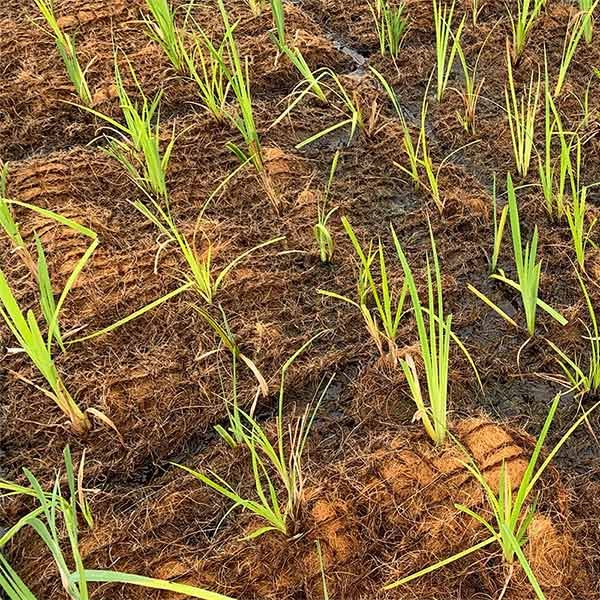Coir Rolls for Ponds and Rivers
Pre-planted (or “pre-vegetated”) coir rolls are a living revetment designed to vegetate and stabilise pond, lake and river banks.
Coir rolls are the simple answer for the rapid and natural establishment of marginal aquatic vegetation.
Coir rolls provide an excellent alternative to a hard revetment wall to establish a ‘soft’ and effective method of erosion control or to establish an immediate habitat.
They also provide crucial enhancements in site biodiversity encouraging flora and fauna into the area.
Our coir rolls less than a year after installation
What is coir exactly?
Coir is a naturally occurring, fibrous layer extracted from the outside of coconuts (the 'hair').
After a long process of separation, softening and sterilisation, the husks are spun into a yarn, which is suitable for a vast array of common applications including rugs, doormats and brushes. Coir is also commonly used for hanging basket liners.
A completely biodegradable fibre, coir offers excellent moisture retention, absorbing up to ten times its own weight in water.
How do coir rolls work?
In the aquatic industry, we use coir as a 'substrate' — that is, a base layer in which organisms can live. Coir rolls and coir pallets allow us to suspend bare-root aquatic plants in the water. The roots of the plant are given time to establish in a controlled environment at our own nursery before being transported to site. When installed with a healthy root system, coir rolls provide instant vegetation to river banks and lake shorelines, acting as an excellent erosion control technique.
Whilst coir rolls give instant erosion protection, it's the speed at which the pre-existing roots can latch on any existing substrate where the impact can really be felt.
Designed to accelerate the establishment of strong and healthy marginal vegetation, a coir roll needs a vigorous and established root system to be most effective.
Advantages of coir rolls
▸ Rapid attachment
▸ Stabilise eroding banks
▸ Soft engineering solution
▸ No soil, peat or plastic pots
▸ Improve water quality and biodiversity
▸ Long-term erosion control
▸ Bolster native wetland plants
▸ Speedy return to a natural state after restoration work
▸ Instant natural habitat for lined ponds and lakes
Coir roll grazing protection
Look carefully and you’ll spot the grazing cages we’ve used on these coir rolls (look on the waterline between the two nearest trees).
Grazing cages protect the plants from wildfowl, deer, badgers and more – giving the coir rolls a greater chance to establish themselves. The cages can be removed in time or since they become so discrete, they can be left in place for ongoing protection.
Grazing cages at Mayesbrook Park, Dagenham
How are coir rolls installed?
Coir rolls are installed in a variety of ways depending on the location. The example here shows a typical installation around the perimeter of a lake or pond, with the addition of a grazing protection cage.
A: Pre-vegetated 300mm dia coir roll
B: Pointed wooden stakes
C: 300mm anti-grazing cage
D: Backfill
How do coir rolls differ to coir pallets?
Coir rolls are a sausage shape, whereas coir pallets are square – ours are 1m x 1m and include eighteen plants.
Coir rolls are the perfect shape for lining banks, easily turning corners and creating a snug fit. Pallets can be used in a similar fashion, however, they serve a much greater impact when used to line the shore or bank, as opposed to using them to create an edge.
This means, when used in conjunction with coir rolls, you are able to create an instant habitat both at the waterline and along the bank.
We also use coir pallets for our Lake Aid Floating Islands.
Coir Roll Case Study
☞ Using coir rolls to create a reed bed
We installed 890m of Coir Rolls, together with 1100m of Rock Rolls to create an inter-tidal reed fringe along the River Roding in Barking.
The versatile coir rolls enhanced the wharf visually, increased biodiversity and help to control the level of silt suspended in the water.
Planting for Coir Rolls
Our native wetland plants are selected for their adaptation to varied physical conditions and also provide excellent cover for invertebrates, fish and other animals. All our rolls are planted at our Merton Hall Ponds nursery using mature bare roots (MBR).
We plant our coir rolls with 6 plants per metre – a mix of four from:
❃ Norfolk reed (Phragmites australis)
❃ Reed canary grass (Phalaris arundinacea)
❃ Reed sweetgrass (Glyceria maxima)
❃ Yellow Flag (Iris pseudacorus)
❃ Purple Loosestrife (Lythrum salicaria)
❃ Greater pond sedge (Carex riparia)
❃ Lesser pond sedge (Carex acutiformis)
❃ Soft rush (Juncus effusus)
We can also contract grow rolls to order – chat to us about your requirements.
Unless grown for contract, all rolls and pallets shall be established for a minimum of one growing season (March to October) under controlled conditions in multi spans.
Our other coir products
We also use coir in the form of woven blankets that are installed as Grass Reinforcement Mesh and Erosion Control Blankets (known as coir ‘geotextiles’).
Erosion control blankets are usually deployed on river banks where the current is strong, or the surface run-off is high. Turf reinforcement on the other hand, is a technique often implemented when strong, vigorous grass would assist in the stabilisation of a bank — or indeed if an area has a high footfall, such as the London Olympic Park, where many visitors frequent the grassy banks of the River Lea.
Unfortunately, coconuts don’t grow in the UK, so we import the highest quality coir from Sri Lanka. Request a quote below.
Request a quote for Coir Rolls










